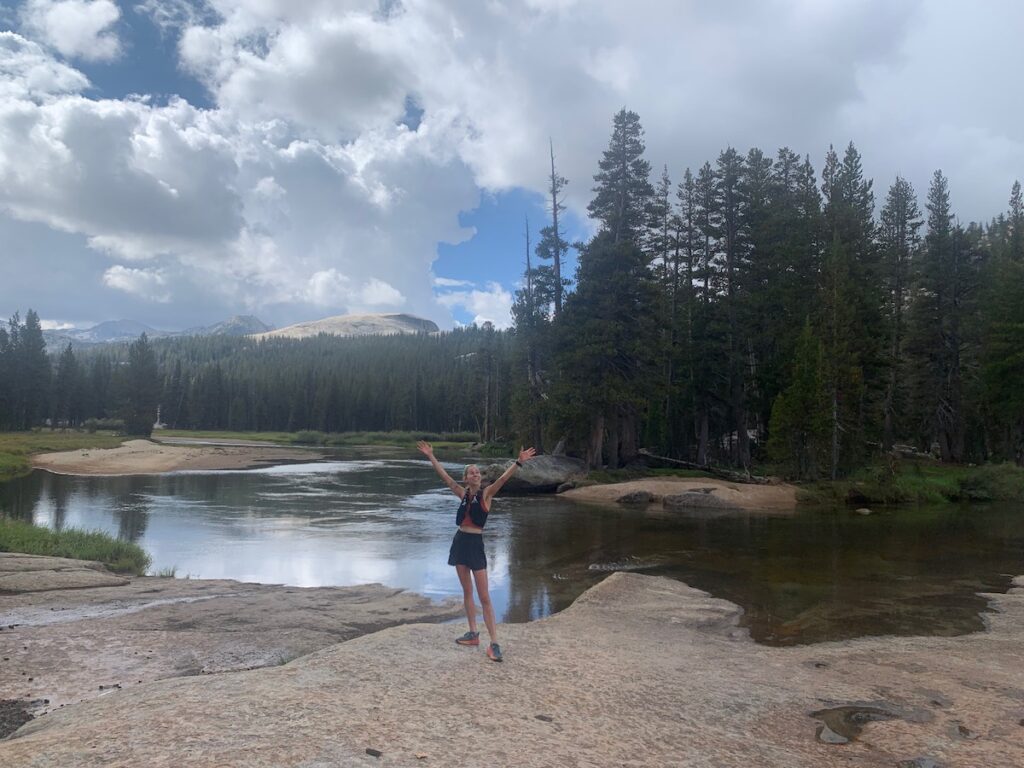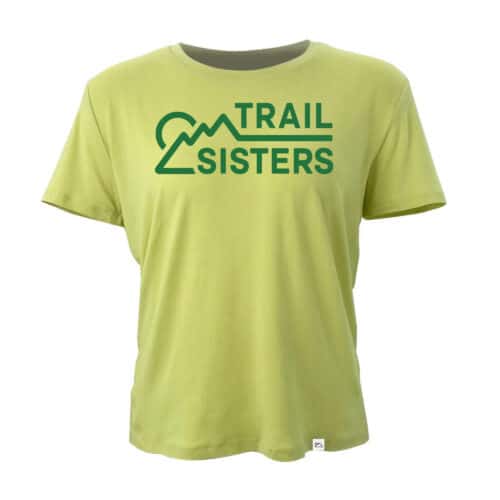Main Menu
Running With Anemia

Hannah Williams is a young professional living in San Francisco, California, balancing her time between working in political research and being a trail-running, rock-climbing, mountain-dwelling fanatic. This year, her love for running has only grown as she’s joined community-based run groups like Queer Run SF, Renegade Running in Oakland, and, of course, her local branch of Trail Sisters. Some of her most authentic relationships have come from spending miles on dusty trails, sharing snacks and diving deep into conversation. An aspiring writer, Hannah hopes that by sharing her own story she can encourage others to do the same, and make the running community as inclusive and empowering a space as possible.
Share This Article!


By: Hannah Williams
It begins in my chest. Small hitches in my hamstrings, a dull pounding in my head when my feet strike the dirt beneath me. I find a rhythm for a beat, then my left toe catches on my right heel and I stumble over myself. Strike two.
I’ve run this trail countless times. I know where the ground meets tree roots, where the hard packed earth erupts to make mountains, or, more often, molehills. Today, climbing one may as well feel like climbing the other.
You’d think I was at mile 23 of my marathon, or racing along the peaks of one of Colorado’s infamous 14ers. Not quite. This was just mile one as a runner recently diagnosed as really, really anemic.
I fell in love with running two years ago. Maybe 1.5 years ago- it was a rocky relationship for the first few months, when every run felt hard and my brain kept up a steady stream of “why do people like this,” a self-deprecating voice that eventually changed its tune to “wait, why do I like this?” As time went on, the runs got longer, and I got stronger. Running became a source of joy, a reclamation of my autonomy and proof that “I could do hard things.” My first half marathon was a tribute to my resilience during a particularly difficult time in my life.
My relationship with running evolved over time. I’ve had intense training eras, casual running eras, a “non-negotiable, I run every morning at 6AM” era. I’ve dabbled in the “I bet I could run this faster” era, before really committing to the “If I can hike it… I can run it?” era, which I’m still in, and for which brought me to Trail Sisters.
This last January ushered in a new era– albeit one more outside of my comfort zone. Having donated most of my worldly goods, taken leave from work and closed out my lease on my apartment, I embarked on three months of solo travel. It was a trip of a lifetime, and one I am incredibly grateful to have experienced.
It was also my first time taking a step back from running since I’d started. It surprised me how uncomfortable I was at the prospect of regressing as a runner. Feelings of shame and fear rose as my mileage dropped, and I was in constant negotiation with myself, making plans for a future “running comeback” to feel better about doing less in the moment.
I hadn’t yet entered the very valuable, sometimes forced “rest to recover” era. I had a bad habit of running through injuries (don’t do that) while thinking rest was the antithesis to growth (don’t think this). Traveling was requiring me to enter a “life that is made all the better by running but isn’t only about running” era (which I now highly recommend).
The day after I landed back in California, I headed back to the trail, breathing in the scent of eucalyptus and bay. The run was…challenging. More than I’d expected, but hey, I’d been pounding medieval cobblestone for the last three months, not traversing ridge lines. I cut myself some slack.
One week later, and my morning run had me doubled over, squeezing my eyes shut to scatter the black dots blurring my vision. Everything hurt, my lungs, my thighs, my hands. I hadn’t broken a sweat, yet my whole body felt wrung out with exertion.

I’d lost fitness, but this? This didn’t make any sense. Just a week before I was managing 5 miles pretty comfortably. It was mile three and the lolling hill before me had sent me reeling.
I felt weak and frustrated, and the insecurities I’d thought I’d moved passed came rushing back. I had tied so much of my identity to a sense of athleticism without realizing the harm that can cause.
It’s all too easy to tether our identities to the things we do. We hold onto our “I am’s” so tightly: I am an engineer, a mother, a teacher. I am a runner, a swimmer, a veteran, a student.
I am weak. I am a failure. I am a fraud.
Have a bad run? I am a “bad runner.”
I have believed these absolutes about myself because I have hinged my own self-worth on the “doing,” and not the “being.” Losing my grasp on running made me feel as though I had lost a grasp on myself.
It took a few calls, a few rushed doctor visits, and five vials of blood before it was confirmed: my iron and hemoglobin counts were critically low. In the span of four months, my iron levels had dropped from a low of 11.5 hm/dl to less than 2, placing me far beyond the spectrum of “iron deficient” and into the category of “anemia,” a condition marked by a severe deficiency of red blood cells or of hemoglobin (an iron-containing protein) in the blood. This leads to a lack of oxygen flow to the body’s organs. As runners, inadequate oxygen-circulation has severe consequences on our athletic performance, causing intense fatigue and slowing recovery both during and after exertion.
Unfortunately, iron deficiency is a common issue among female runners. The sheer exertion of running, tied with blood loss during menstruation and the all-too common issue of restrictive dieting and under-eating among female athletes, makes maintaining a balanced iron store difficult. Symptoms can range from unnoticeable to all-consuming, and while there are solutions in the forms of supplementation and infusions, medical assistance remains often inaccessible.
Suffice to say, anemia is a complicated medical issue. It’s a mental struggle, too, a chronic exhaustion that required me to put in some serious work re-evaluating my relationship with running, and to find out who I was as a person first, not just as an athlete.
Running with anemia taught me that we are more than what we do. We may pack our schedules to the brim with our commitments but somewhere at the center of it all is our why, and that why is the point of it all. Lose the job, change hobbies, move on from a friendship, our “doings” are expressions of who we are, which is why they can (and should) change.
It becomes harder to accept this when that “change” feels like a choice made for us, by situations beyond our control. Illness and injury are excellent teachers as they force us to stop when stopping is probably the last thing on our mind. My “rest and recover” era wasn’t what I thought I wanted, but it was what I needed.
One of the reasons I love to run is because it taught me how to show up for myself. When I was anemic, showing up for myself looked like doctor’s appointments and nutrition counseling, infusions and supplements. I began this essay in the throes of it all, letting the thoughts and feelings heavy on my mind spill out to say “yes, this is real. Yes, this sucks. And yes, you are still enough.”

I love running because it helps me be less afraid.
Today, I choose to be fearless, regardless of whether or not I run.
Running was there for me when I was ready. I committed to infusions and monitoring my iron levels regularly, adjusting nutrition where I needed to and prioritizing rest and recovery. I withdrew from a marathon, knowing I needed more time. I am lucky to have had access to the medical support I needed, a privilege, I know.
Like everything in life, our running journeys will ebb and flow with time. Our only responsibility is to respond to that current with resilience and grace, to remember that something being delayed does not mean that it’s being denied to us. It just may require a bit more time, a little more patience.
I am not sure what to title my current running era. My iron levels have returned to normal, and I have found joy again in running- and much more ease with the idea of not. A few weekends back, I crossed the finish line of my first ever marathon, a long time coming. It was worth the wait.
As runners, we must learn to respond to change. Your next run will look and feel different from your last- as will the next, and the next. All we can do is take it day by day, step by step. Run by run.
About the Author

Hannah Williams is a young professional living in San Francisco, California, balancing her time between working in political research and being a trail-running, rock-climbing, mountain-dwelling fanatic. This year, her love for running has only grown as she’s joined community-based run groups like Queer Run SF, Renegade Running in Oakland, and, of course, her local branch of Trail Sisters. Some of her most authentic relationships have come from spending miles on dusty trails, sharing snacks and diving deep into conversation. An aspiring writer, Hannah hopes that by sharing her own story she can encourage others to do the same, and make the running community as inclusive and empowering a space as possible.
Share This Article!




















2 Responses
Thanks. Great article. At age 63, I think I hit a similar wall. 40-60 miles a week with lots of high intensity interval training, not eating enough and I became exhausted last week. I will get blood tests next week, but I fear that I am anemic too. How long did it take for you to recover.
Hey James! I’m sorry to hear of your recent struggles. While there are many things that can contribute to low energy and stunted recovery- it’s worth checking iron levels deficiency or anemia.
There’s not really a standard timeline for recovery, and I encourage you to talk to you Doctor about strategies that go beyond supplementation or iron infusion- nutrition changes, including adding more iron to your diet, prioritizing sleep and recovery, etc. Personally, I started rebounding about a month after my first infusion, and stabilized after two rounds (four months total). I’ve had to keep a close eye on it, however! Good luck, friend!